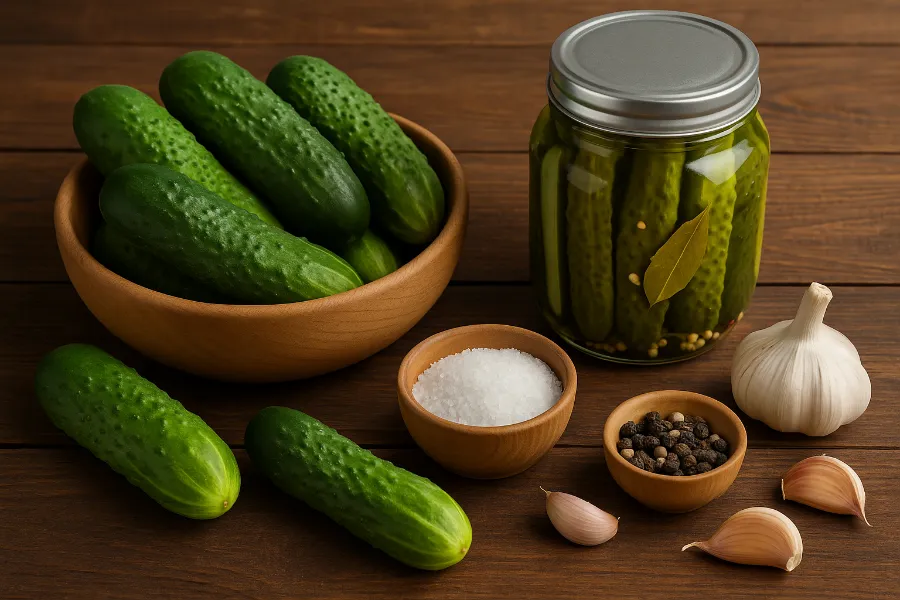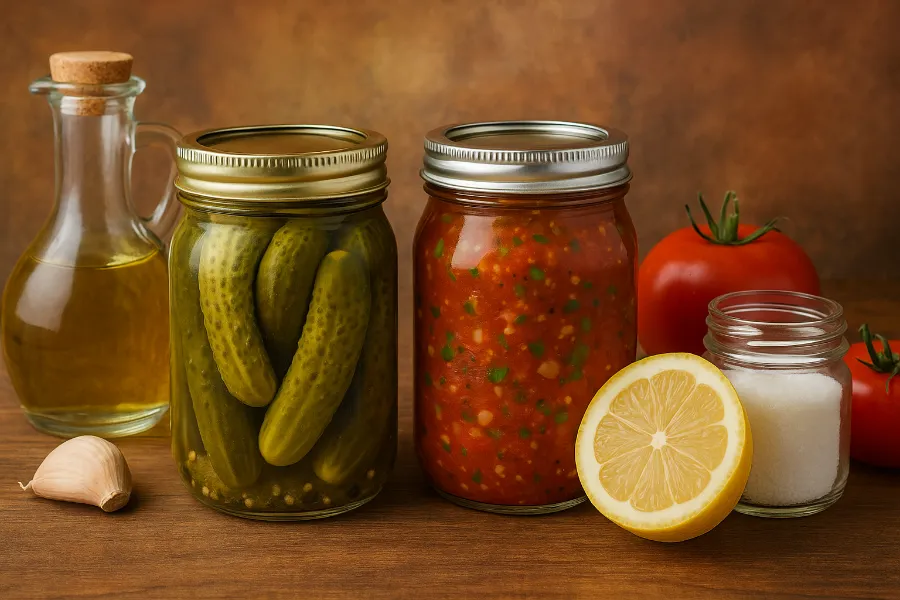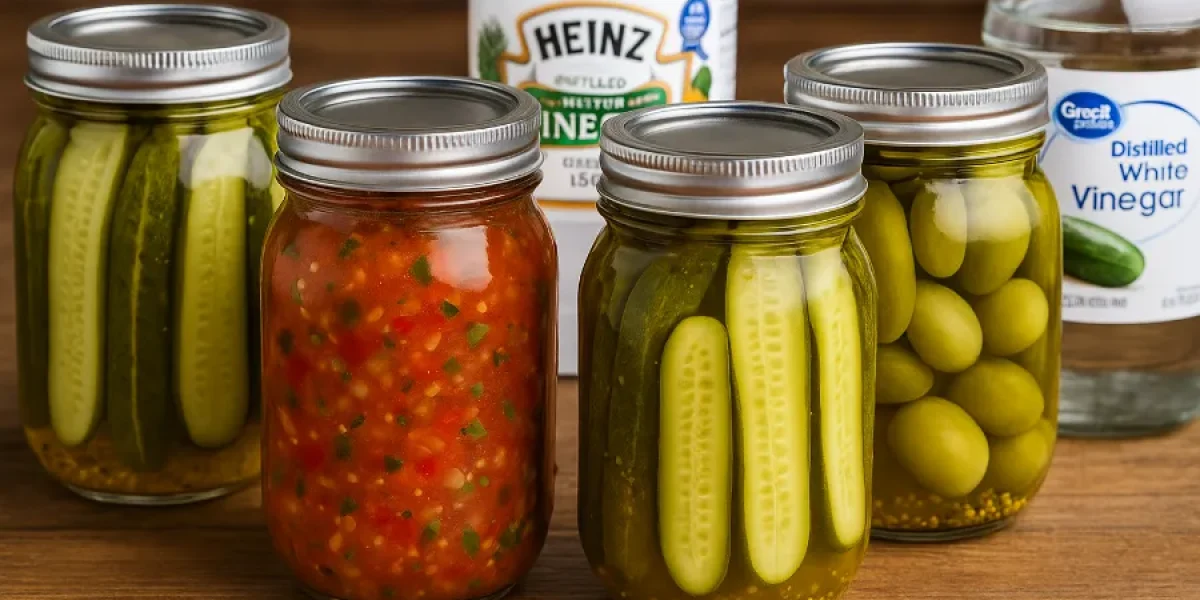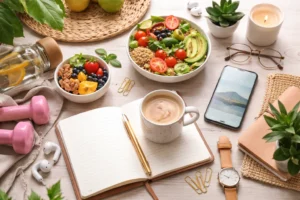Every canner I know has that one “aha” moment mine came the year I learned about citric acid for canning. I had jars of beautiful salsa lined up on the counter, but a friend with a food science background asked a simple question: “What’s the pH on those?”
At the time, I didn’t know the exact number, but that conversation changed how I approached home preservation forever. Since then, I’ve become a little obsessed with understanding safe acid levels for canning salsa and pickles and how citric acid can quietly guarantee safety without compromising flavor.
This post is a deep dive into the acids that protect our jars what works, what doesn’t, and how to balance tradition with science.
Pickle Brine Ratio: The Foundation of Safe Preservation

Before we even talk citric acid, let’s start where all good pickles begin — the pickle brine ratio. It’s not just about taste; it’s the formula that determines whether your jars are shelf-stable or risky.
For a safe brine, I follow this simple 1-1-1 rule:
- 1 part 5% vinegar
- 1 part water
- 1 tablespoon pickling salt per pint
That combination keeps your brine’s pH in the sweet spot between 3.0 and 3.5, far below the botulism danger line of 4.6.
Now, when I add citric acid for canning, I use it to boost not replace vinegar. A pinch (⅛ teaspoon per pint) increases the acidity slightly without making the pickles harsh. It’s my favorite trick when I want milder flavor but the same safety margin.
pH Meter for Canning: The Modern Homesteader’s Best Friend
For generations, canners relied on experience and a good nose but today, we’ve got better tools. A pH meter for canning has become as essential in my kitchen as my jar lifter.
Testing acidity isn’t overkill; it’s confidence. I love being able to say, “Yes, that salsa came out at a perfect 4.1.”
Here’s how I test:
- Stir your salsa or brine well.
- Cool a small sample to room temperature.
- Dip the probe in the liquid (not the chunks).
- Wait for the reading — aim for 4.6 or lower.
If you’re off by a bit, just stir in more acid — lemon juice, vinegar, or citric acid — and retest.
I started using a digital pH meter after reading studies from the National Center for Home Food Preservation. Since then, I’ve never had a single failed batch. It takes the guesswork out of preserving.
pH Testing for Canning: The Science Behind Safe Food

If a digital meter feels intimidatinall-batch projects.
When I teach canning workshops, I hand them out to show how acid changes everything. Tomato salsa before acid? Usually around 4.8. After adding lemon juice or citric acid? It drops to 4.2 — safe territory.
Seeing that color shift always gets people excited — it’s visual proof that the science works.
The safe threshold — that magical 4.6 — isn’t arbitrary. It’s the point below which Clostridium botulinum can’t survive. So whether you’re canning salsa, tomato sauce, or pickles, think of your pH test as the key that unlocks both flavor and safety.
Bottled Lemon Juice for Canning: Bright, Reliable, and Proven
Before I discovered citric acid, my go-to acidifier was bottled lemon juice for canning. It’s standardized to a pH around 2.0, which makes it a dependable choice every time.
When using it, the usual rule is:
- 1 tablespoon per pint
- 2 tablespoons per quart
Bottled lemon juice keeps the tangy, bright note that tastes perfect in tomato salsa. Fresh lemons, by contrast, vary in acidity — one might measure 2.3, another 3.0 — which could mean the difference between safe and spoiled.
Now, I sometimes mix both citric acid and lemon juice: a touch of powder for precision, a dash of juice for brightness. It’s the best of both worlds — scientific accuracy and homemade flavor.
Vinegar Acidity for Pickling: The 5% Golden Rule
When it comes to pickling, vinegar acidity for pickling is non-negotiable. Always, always use vinegar that’s labeled 5% acidity.
Lower than that, and you can’t guarantee your brine will hit the safe pH zone. It might look fine in the jar, but the chemistry says otherwise.
The most reliable vinegars for home canning are:
- White distilled vinegar (5%) – crisp and neutral.
- Apple cider vinegar (5%) – mellow, slightly sweet.
I often enhance vinegar pickles with a pinch of citric acid — it keeps the acidity stable even if the cucumbers release water during processing. That tiny adjustment helps ensure the final product stays under 4.0 pH.
What Vinegar Is Best for Pickling?
If you’ve ever stood in front of the vinegar shelf at the store, you know the choices can be dizzying. So, what vinegar is best for pickling?
Here’s what I’ve learned from both experience and USDA recommendations:
- White vinegar (5%) is perfect for colorful pickles because it doesn’t darken the brine.
- Apple cider vinegar (5%) adds depth to bread-and-butter or sweet pickles.
- Wine vinegars are fine if they’re labeled 5%, but their flavors can overpower delicate herbs.
- Rice vinegar can work — only if it’s exactly 5% acidity. Many brands are weaker, around 4%.
Avoid homemade or “artisan” vinegars unless you’ve tested their acidity yourself. If in doubt, supplement with citric acid for canning to maintain that safety buffer.
Natural Food Preservation: Blending Tradition and Modern Science
I’ve always believed natural food preservation is a balance of old wisdom and new understanding.
Our great-grandparents didn’t talk about pH or citric acid — they relied on high-acid vinegars, lots of salt, and intuition. Their methods worked because their ingredients were naturally stronger and less diluted than many modern products.
Today, we’ve got tools and powders that make those same results more predictable. Citric acid, for instance, is simply the purified form of what lemons have always done.
Used properly, it enhances food safety without changing flavor. It’s especially helpful when you’re canning low-acid vegetables, hybrid tomatoes, or modern cucumber varieties bred for sweetness rather than tang.
The result? Safer jars that taste exactly the way you want them to.

How I Use Citric Acid for Canning Salsa
Let’s talk salsa — because if there’s one place I don’t compromise on acid, it’s here.
Tomatoes hover right on the pH line between safe and unsafe, and when you add onions, peppers, or garlic, the mix drifts even higher.
To fix that, I use ¼ teaspoon citric acid per pint jar or ½ teaspoon per quart. It’s simple, measured, and tasteless. Sometimes I combine it with a bit of bottled lemon juice for brightness.
I learned this method after reading research from the University of Georgia and experimenting with my own garden harvest. The results? A perfectly tangy salsa that stays shelf-stable for 18 months.
How I Use Citric Acid for Canning Pickles
For pickles, I mostly rely on vinegar, but citric acid for canning plays an important backup role.
If I’m making a lighter brine say, half vinegar and half water I’ll add ⅛ teaspoon citric acid per pint of brine. It doesn’t add flavor, just safety insurance.
Sometimes, when I use sweeter vinegars like apple cider or wine vinegar, the acid balance can vary. A pinch of citric acid corrects that, ensuring my brine’s pH stays around 3.3 to 3.6.
The payoff? Crisp, tart pickles that store beautifully no soggy surprises, no safety worries.
Common Mistakes When Using Acid in Canning
After years of canning (and a few lessons learned the hard way), here are the top mistakes to avoid when working with acid levels:
- Using homemade vinegar – You can’t verify its acidity without testing.
- Skipping acid altogether – Even tomato salsa needs added acid.
- Using fresh lemon juice inconsistently – Stick with bottled or citric acid.
- Diluting vinegar too much – More water means higher pH.
- Assuming salt makes food safe – Salt preserves texture and flavor, not acidity.
Each of these mistakes can raise your pH and make food unsafe for water-bath processing.
How to Measure Citric Acid and Process Jars Safely
When using citric acid, the process is simple:
- Measure ¼ teaspoon per pint (or ½ teaspoon per quart).
- Stir directly into your salsa or brine before heating.
- Use a pH meter for canning or test strip to confirm acidity.
- Process in a boiling water bath — 15 to 20 minutes depending on altitude.
- Cool jars undisturbed for 12 to 24 hours.
That’s it. No special equipment, no fancy chemistry. Just careful measurement and clean jars.
Why I Prefer Citric Acid Over Other Additives
Over the years, I’ve used lemon juice, vinegar, and citric acid interchangeably. But citric acid has earned a permanent spot on my pantry shelf because:
- It’s flavor-neutral (doesn’t change your recipe’s taste).
- It’s precise and measurable (no pH guessing).
- It’s easy to store (a little goes a long way).
Plus, it’s economical — a small container lasts multiple canning seasons.
It’s the unsung hero of safe home preservation, especially for anyone who wants the confidence of scientific accuracy with the soul of traditional canning.
The Final Seal: Safe, Simple, and Satisfying
Canning connects us to generations before us — but now we have the science to make it safer than ever.
Using citric acid for canning gives you the best of both worlds: a nod to the wisdom of vinegar pickles and lemony salsa, and the precision of modern food safety.
Each time that lid pops, I feel a small burst of satisfaction. Not just because it sealed — but because I know it’s truly safe.
That’s the beauty of understanding acidity — you’re not guessing, you’re mastering a craft.
Quick Reference: Safe Acid Guidelines for Canning
| Food Type | Safe Acid Additive | Recommended Amount | Safe pH Target |
|---|---|---|---|
| Tomato Salsa | Citric acid or bottled lemon juice | ¼ tsp per pint / ½ tsp per quart | ≤ 4.6 |
| Pickles | 5% vinegar + optional citric acid | 1 part vinegar : 1 part water + ⅛ tsp citric acid | ≤ 3.6 |
| Relish / Chutney | Vinegar or lemon juice | At least 1 cup vinegar per quart mix | ≤ 4.0 |
My Takeaway on Natural Food Preservation
Preserving food isn’t just about storing harvests — it’s about preserving knowledge.
I still use my grandmother’s pickle spices, but now I add a pH meter and a spoonful of citric acid to the mix. The flavor’s the same, but the peace of mind? Priceless.
Safe acid levels for canning salsa and pickles aren’t a mystery once you understand the balance between vinegar, lemon juice, and citric acid.
If you’ve never used citric acid before, give it a try this season. It might just become the quiet hero in your canning pantry — the ingredient that guarantees every jar is as safe as it is delicious.
FAQs
Citric acid for canning helps lower the pH of foods like salsa and pickles to safe levels below 4.6, preventing botulism and spoilage. It offers precise, consistent acidity without altering flavor.
Use ¼ teaspoon of citric acid per pint or ½ teaspoon per quart of salsa. Mix it in before processing to evenly distribute the acid and ensure food safety.
Yes, citric acid can replace vinegar or bottled lemon juice as long as you measure accurately. It provides the same acidity control but without changing the recipe’s taste.
A safe brine ratio is 1 part 5% vinegar to 1 part water with 1 tablespoon of salt per pint. You can add ⅛ teaspoon citric acid for extra safety and balanced flavor.
Use a pH meter or test strips to ensure your mixture is at or below 4.6. If the reading is higher, add more citric acid or bottled lemon juice and retest.
Always use vinegar labeled 5% acidity, such as white distilled or apple cider vinegar. Avoid homemade or flavored vinegars unless you’ve confirmed their acid levels with testing.
Yes, citric acid is a naturally occurring compound from citrus fruits. It’s a safe, natural way to preserve food and maintain consistent acid levels for long-term storage.













